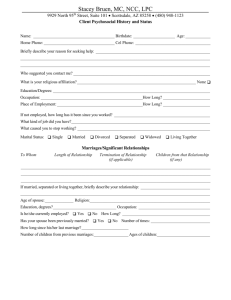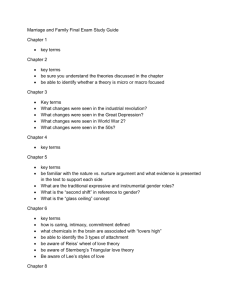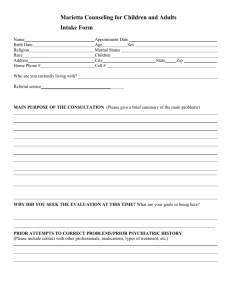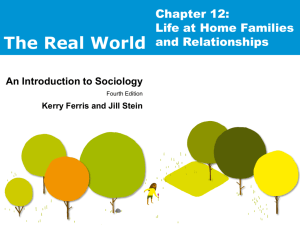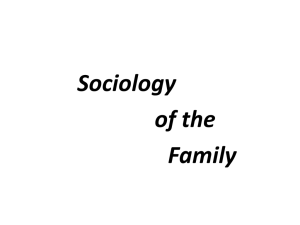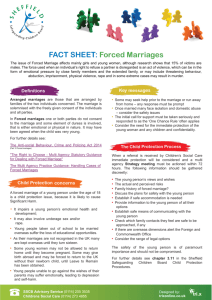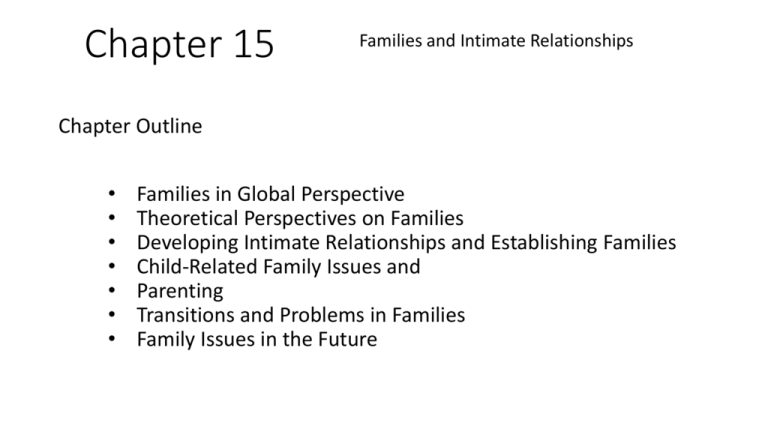
Chapter 15
Families and Intimate Relationships
Chapter Outline
•
•
•
•
•
•
•
Families in Global Perspective
Theoretical Perspectives on Families
Developing Intimate Relationships and Establishing Families
Child-Related Family Issues and
Parenting
Transitions and Problems in Families
Family Issues in the Future
Families in Global Perspective
The Census Bureau defines a family as consisting of two or more people who are related by birth,
marriage, or adoption, and residing in the same housing unit.
New Definition of Family
• Relationships in which people live together ___________________________________________
Kinship refers to a social network of people based on common ancestry, marriage, or adoption
Family of orientation is the family into which a person ___________________________________
Family of procreation is the family a person ____________________________________________
An extended family is composed of relatives in addition to parents and children who live in the same
household
A nuclear family is composed of one or two parents and their dependent children, all of whom live
apart from other relatives
Marriage
• Legally recognized arrangement between two or more individuals that carries certain rights
and obligations and usually involves a sexual relationship
• Establishes a system of descent so kinship can be determined
Monogamy is a marriage ______________________________________________
Polygamy is the concurrent marriage of a person with two or more members of the opposite
sex
A patriarchal family is a family structure in which authority is held by the eldest male
(usually the father)
A matriarchal family is a family structure ________________________________________
An egalitarian family is a family structure _________________________________________
Marriage Patterns
• Endogamy is the practice of marrying within one’s own group
• Homogamy is the pattern of individuals marrying those who have similar
characteristics, such as race/ethnicity, religious background, age, education,
and/or social class
• Exogamy is the practice of marrying outside one’s own social group or
category
• A common variation of monogamy is serial monogamy:
__________________________________________________________________
• In the United States, Congress outlawed polygamy in 1892; thus, being married to more than one spouse is a crime
referred to as bigamy.
Functionalist Perspective
• Functionalists emphasize the importance of the family in maintaining the stability
of society and the well-being of individuals
4 Functions of Families::
According to the structural-functionalist perspective, traditional gender roles contribute to family
functioning: Women perform the “expressive” role of managing household tasks and providing
emotional care and nurturing to family members, and men perform the “instrumental” role of
earning income and making major family decisions
Families in capitalist economies are similar to workers in a factory:
Women are dominated at home the same way workers are dominated in factories
Reproduction of children and care for family members reinforce subordination of women
through unpaid labor
Symbolic Interactionist Perspective
• How family problems are perceived and defined depends on:
• Patterns of communication
• The meanings people give to roles and events
• Individual interpretations of family interactions
• The symbolic interactionist perspective is concerned with_________________________________.
• Symbolic interactionists also point to the effects of interaction on one’s self-concept, especially the
self-concept of children.
• The symbolic interactionist perspective is useful in understanding ____________________________
Changing Relationship Patterns
• Our culture emphasizes romantic love
• Men and women may have different perceptions of romance
Domestic Partnership
• Household partnerships in which an unmarried couple lives together in a committed, sexually intimate
relationship and is granted the same rights and benefits as those accorded to married heterosexual
couples
Cohabitation refers to a couple who ___________________________________________________________
Based on Census Bureau data, the people who are most likely to cohabit are under age 45, have been married
before, or are older individuals who do not want to lose financial benefits (such as retirement benefits) that are
contingent upon not remarrying
• Cohabitation somewhat follows the two-stage marriage pattern set out by anthropologist Margaret Mead
• Mead suggested marriage should occur in two stages:
• Individual marriage: two people make a commitment to each other but agree not to have children
during this stage
• Parental marriage: couple decides to have children and share responsibility for them
Why People Get Married
• Being "in love"
• Desiring companionship and sex
• Wanting to have children
• Social pressure
• Attempting to escape from their parents' home
• Believing they will have greater resources
Housework and Child-Care Responsibilities
Today, over 50% of all marriages in the United States are dual-earner marriages: marriages in which both
spouses are in the labor force
In 2001, more than 76% of employed mothers with children under age 6 worked full time
The second shift is the domestic work that employed women perform at home after they
complete their workday on the job
Society's bias is to assume having children is the norm
Approximately 44% of pregnancies in the U.S. are intended
Infertility affects nearly five million U.S. couples, or one in twelve couples in which the wife is
between the ages of fifteen and forty-four.
Adoption is a legal process through which the rights and duties of parenting are transferred from
a child's biological and/or legal parents to new legal parents
Teen Pregnancies
• The U.S. has the highest rate of teen pregnancy in the Western industrialized world
•
•
•
•
Many sexually active teens don’t ________________________________
Teenagers may receive little accurate information about ________________________________
Some teenage males believe females should be responsible for contraception
Some teenagers view pregnancy as a sign of male prowess or as a way to gain adult status
They engage in sexual activity early and often
They sexually exploit unsuspecting females
They have a need to prove their masculinity
They have few emotional feelings for the women they impregnate
They are rarely involved in caring for and rearing their children
For good or ill, families are central to our existence
The reality of family life is far more complicated than the idealized image of families found in the media
and in many political discussions.
Single Parent Households
• The number of single parent households is increasing
• About 25% of U.S. households are maintained by single parents who live with their own children under the
age of 18
• Lesbian and gay parents are often counted as single parents; however, many share parenting with partner
Two-Parent Households
• In 2010, almost 70% of children lived with two parents
• Parenthood in the United States is idealized, especially for women
Family Violence
• Women are more likely than men to be the victim of violence perpetrated by intimate partners
• About ½ of the intimate partner violence against women is reported
• Between 3 and 10 million children witness domestic violence each year; children who witness DV
are at greater risk of abusing their own children or partners
• Intimate partner abuse also takes the form of sexual aggression, which refers to sexual interaction
that occurs against one’s will through use of physical force, threat of force, pressure, use of alcohol or
drugs, or use of position of authority.
• In most cases of rape or sexual assault of females—about 8 in 10 cases—the offender is an intimate
partner, family member, friend, or acquaintance.
• In the United States, women are more than four times more likely to be victims of IPV than are
men. Globally, 1 in 3 women will experience violence in an intimate relationship.
• Domestic violence (Intimate Partner Abuse IPV) refers to any intentional act or series of acts—
whether physical, emotional, or sexual—by one or both partners in an intimate relationship that
causes injury to either person.
• Cycle of Abuse: A pattern of abuse in which a violent or abusive episode is followed by a makeup
period when the abuser expresses sorrow and asks for forgiveness and “one more chance,” before
another instance of abuse occurs.
Child maltreatment has a negative effect on health. Abused children often suffer physical injuries
including cuts, bruises, burns, and broken bones. In addition, maltreatment causes stress that can
disrupt early brain development. Extreme stress can harm the development of the nervous and
immune systems. As a result, children who are abused or neglected are at higher risk for health
problems as adults. These problems include alcoholism, depression, drug abuse, eating disorders,
obesity, high-risk sexual behaviors, smoking, suicide, and certain chronic diseases
Some factors can increase the risk for abuse or neglect. The presence of these factors does not always
mean that maltreatment will occur. Children are never to blame for the harm others do to them.
• Age: Children under 4 years of age are at greatest risk for severe injury and death from abuse.
• Family environment: Abuse and neglect can occur in families where there is a great deal of stress.
The stress can result from a family history of violence, drug or alcohol abuse, poverty, and chronic
health problems. Families that do not have nearby friends, relatives, and other social support are
also at risk.
• Community.: Poverty, on-going community violence, and weak connections between neighbors are
related to a higher risk for child abuse and neglect.
Foster Care
• Foster care refers to institutional settings or residences where adults other than the child's own
parents or relatives care for the child
The annual report from the Department of Health and Human Services tallied 402,378 children in the
foster care system as of Sept. 30, 2013, up from about 397,000 a year earlier, but still down
dramatically from a decade earlier. The peak was 524,000 children in foster care in 2002, and the
number had dropped steadily since 2005.
The long-term drop resulted primarily from a shift in the policies and practices of state and county
child welfare agencies. Many shortened stays in foster care, expedited adoptions and expanded
preventive support for troubled families so more children avoided being removed from home in the
first place.
The average length of stay in foster care has been reduced by more than 10 percent since 2002,
according to the report. The mean stay is now 21.8 months.
Of the children in foster care a year ago, 52% were boys, 22% were Hispanic, 24 % black and 42 %
white; 101,840 of them were available for adoption.
During the 2013 fiscal year, 50,608 children were adopted from foster care, down from 52,042 in 2012, while 23,090 youths in their late teens
aged out of the system without being placed with a permanent family.
From CNN: Conservative studies find one in five will become homeless after 18; at 24, only half will be
employed; less than 3% will have earned a college degree; 71% of women will be pregnant by 21; and
one in four will have experienced post-traumatic stress disorder at twice the rate of United States war
veterans. And too often, many are at risk of moving back into government systems -- from juvenile
centers to prison.
To report child abuse:
To report child abuse:
Please call the DFCS Child Protective Center at: 1-855-GACHILD / 1-855-422-4453.
Reports are taken 24 hours a day, 7 days a week.
If you have an immediate emergency, please call 911 or your local police department.
Divorce
• _______% of first marriages end in divorce within 15 years
• Effects on Children and Young Adults
• Parental divorce is a stressful event for children and is often accompanied by a variety of stressors, such as
• continuing conflict between parents
• a decline in the standard of living
• moving and perhaps changing schools
• separation from the noncustodial parent (usually the father)
• parental remarriage
• These stressors place children of divorce at higher risk for a variety of emotional and behavioral problems.
Characteristics of Those Likely to Get Divorced
• Marriage at an early age
• A short acquaintanceship before marriage
• Disapproval of the marriage by relatives and friends
• Limited economic resources
• Having a high-school education or less
• Parents who are divorced or have unhappy marriages
• The presence of children at the beginning of the marriage
Remarriage
• In recent years, more than ______% of all marriages were between previously married brides and/or
grooms
• Among individuals who divorce before age thirty-five, about half will remarry within three years of their
first divorce.
• Some people become part of stepfamilies or blended families, which consist of a husband and wife,
children from previous marriages, and children (if any) from the new marriage
Reasons for staying single are varied
Career interests
Readily available sexual partners without marriage
Exciting lifestyle
Desire for freedom and independence
Lack of partner
Economic necessity
Biracial Families
• The Supreme Court overturned miscegenation laws in 1967
• Since the 1970s, there has been a 300% increase in marriages between people of different
races
• Most biracial and bicultural children find that they have an enhanced ability to understand
the meaning of race and culture in daily life
Families and intimate relationships changed dramatically during the 20th century
People's perceptions of desirable family life will continue to change.
Many people demonstrate their faith in the future by choosing to have children

